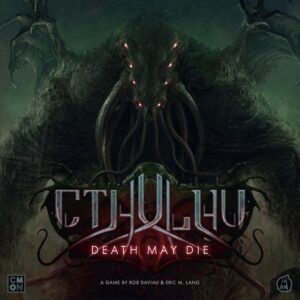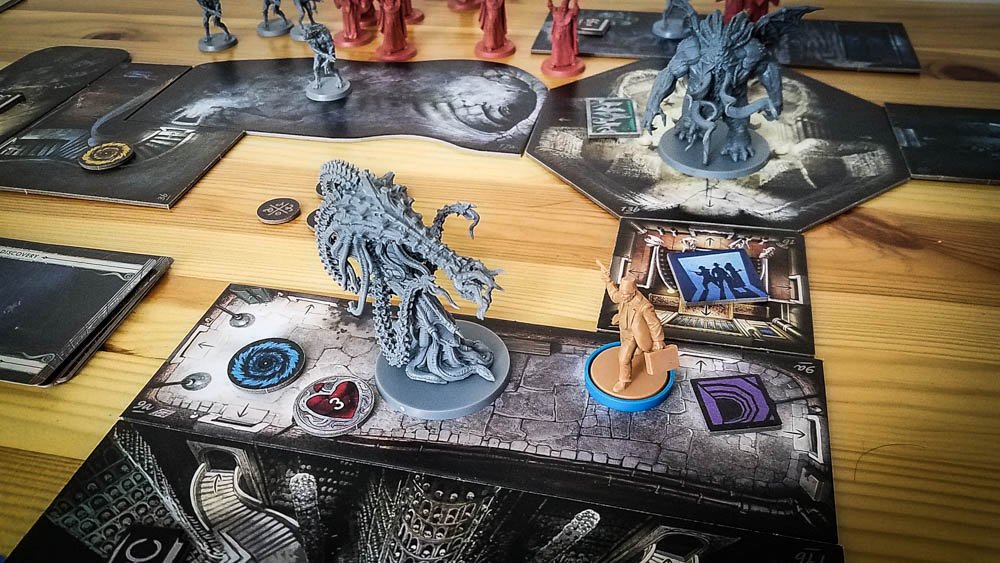Cthulhu: Death May Die Review
Year: 2019 | Players: 1-5 | Minutes: 90+ | Ages: 14+
This Cthulhu: Death May Die review was made after playing the game five times.
What is Cthulhu: Death May Die?
Cthulhu: Death May Die is a cooperative horror board game set in H.P. Lovecraft’s popular universe. You play as investigators and your job is to disrupt the cultists’ ritual, summon an Elder One into our world at its most vulnerable, and defeat it once and for all.
Cthulhu: Death May Die was designed by Rob Daviau (Pandemic Legacy) and Eric Lang (Blood Rage), and published by CMON.
Rules Overview
To set up a game of Cthulhu: Death May Die, you’ll choose one of the Elder Ones’ boxes – either Cthulhu or Hastur in the base game – and then mix in the contents of one of the six episode boxes. The episode card will tell you how to set up the map, the types of enemies you’ll be facing, any special rules for the scenario. Your goal is always to summon the Elder One and defeat it.
Each turn has four phases:
- Take 3 Actions – You can move, attack enemies, heal, trade items, and do unique actions shown on the episode cards. The actions on the episode cards are the ones you’ll need to perform to disrupt the ritual and summon the Elder One.
- Draw Mythos Card – Half of the Mythos deck is from the Elder One’s box and half is from the episode’s box. These cards can add monsters to the map, move monsters around, and hurt the investigators in different ways. They can also have Elder One symbols on them, which can impact the End of Turn phase.
- Investigate or Fight – If you’re in a safe space (no enemies), you’ll get to draw a Discovery card that will usually give your investigator a unique item or companion, but it could also end up giving you a negative condition. If you have enemies in your space, they’ll attack you and you won’t get to draw a Discovery card.
- End of Turn – If there are three Elder One symbols in the Mythos card discard pile, you’ll advance the Elder One on its track, which will activate some nasty abilities. If you did what you needed to do to disrupt the cultists’ ritual, the Elder One is put on the map and you’ll be able to start attacking him. This is also when the End of Turn effects on the Elder One’s cards and some Discovery cards activate.
Each investigator board has tracks for their sanity, their stress, their health, and their three skills. Sanity and skills are connected in this game; the more insane you get, the more you’ll be able to upgrade your skills. Each investigator also has an Insanity card that will activate every time the sanity marker reaches the red Insanity Thresholds.
When you attack, you roll the three black dice plus any green bonus dice you get from skills and other abilities. Each enemy’s card lists the dice they get to roll. Successes count as hits for whoever attacked, tentacles raise your insanity regardless of whether it was you or the enemy who rolled them, and Elder Signs only take effect if an ability uses them. You can use your stress to reroll dice.
You’ll win if you’re able to defeat the Elder One. You’ll lose if any investigator dies or goes completely insane before the Elder One is summoned, if everyone dies/goes insane after it’s summoned, or if the cultists complete the ritual by reaching the final space on the Summoning track.
Check out the Cthulhu: Death May Die rulebook (PDF) to learn more about how the game plays.
Pros and Cons
Pros
- Cthulhu: Death May Die’s scenario variety is easily the highlight of the game for me. They give you very different types of puzzles to solve and it’s great that they can be used with any Elder One that you want to face.
- The whole “sanity” system gives you some interesting strategic decisions to make throughout each game. You want to get more insane so you can upgrade your abilities, but you don’t want it to go up so fast that you end up going completely insane before you defeat the Elder One. It’s a fun little balancing act. The Insanity cards also change up how your investigator approaches each scenario.
- I like how the Mythos deck works. Not only is it the classic “bad things happen” deck found in most co-ops, it’s also a timer for the Elder One you’re facing.
- There’s a nice amount of tension in this game. The enemies are always chasing you (and a bunch of them are HUGE), you’re always worried about those Mythos cards, and your dice rolls do the job of keeping you on the edge of your seat when you’re in sticky situations.
- There are a lot of investigators to choose from (10 in the base game) and each one has a different play style. The three skill tracks, the Insanity card, and the Discovery cards do make you feel like a unique character by the end of the game.
- The rules for Cthulhu: Death May Die are surprisingly straightforward. Plus, all of the special rules are right there on the scenario cards. I taught this to two new gamers and they had it down after about three rounds.
- I appreciate that the Elder One and scenario boxes include the full lists of components. You don’t have to worry about things getting mixed up.
Cons
- You will run out of room for miniatures on some of the tiles. If you happen to be standing on a smaller tile and two or three enemies show up, you probably aren’t going to have enough room for everyone to fit. That becomes a bigger problem when there are important tokens on the tiles that either need to be covered up or moved to the side. I think a lot of people would want larger tiles, but I’d prefer smaller miniatures.
- You can get completely ruined by dice and card randomness in this game. One guy in my group had three consecutive bad rolls against enemies, then a Mythos card put two more enemies in his space, he got hit hard after failing on his rerolls, and we lost. It was still a fun game, but it wasn’t a great ending.
- Besides the Elder Ones, the monsters in Cthulhu: Death May Die aren’t as interesting as I had hoped. Most of them just have one very basic ability and different combinations of dice.
- Some investigator groups seem to work a lot better than others. That’s especially true when playing with fewer players and you don’t have anyone with Arcane Mastery, which makes Elder Signs count as successes.
Final Thoughts
I lost interest in Cthulhu games a few years ago, but I gave Cthulhu: Death May Die a shot because I’m a big fan of both of the designers. Well, I’ve had a lot of fun playing this one. I think that’s because there isn’t much of a story to follow, allowing you to get right in there to complete your tasks and fight some pretty cool-looking enemies with some interesting heroes. I like the look of the game, it’s easy to teach, it’s quicker to set up than most other games of this type, and the Elder One-scenario-investigator combos give the game plenty of replay value.
If you’re a fan of Cthulhu games, you’ll probably love Death May Die. If you’re not and you don’t want to take a chance on this one, I suggest looking into Village Attacks, which I think has a similar feel and a more interesting theme.
- Update: Cthulhu: Death May Die was included on the Top Cooperative Board Games of 2019 list!
- Update 2: It also made it onto our Best Horror Board Games list!
- Update 3: It’s now on the Top 10 Dungeon Crawlers page!
- Update: It was also added to the Best Board Games for Three Players list!
Cthulhu: Death May Die Links
BGG | Amazon | Miniature Market
Thanks for taking the time to read our Cthulhu: Death May Die review!
Be sure to also take a look at our Best Cooperative Board Games list and other rankings.
Subscribe to our newsletter if you want more co-op board game content sent right to your inbox!




